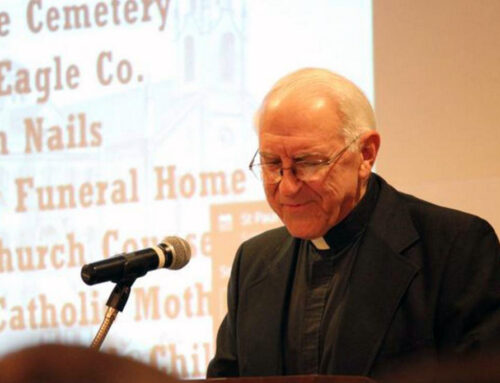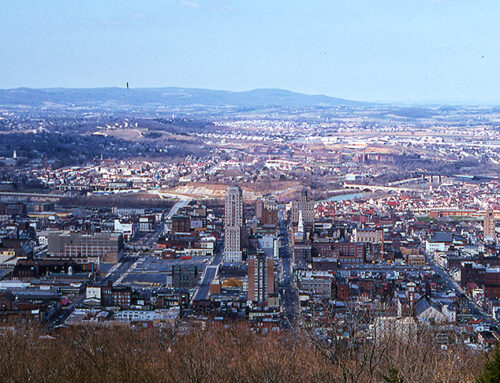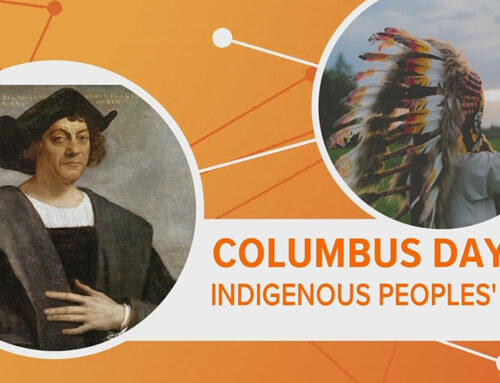By 1910 it was clear to Reading’s leaders that the biggest progress was quickly moving beyond the City limits. A few new suburban industries were already finding their locations an asset. Lower land prices were attractive, there were fewer restrictions on developable land, and local transportation helped by extending trolley lines into suburban areas.
The typical big industry was getting bigger, and it was becoming infeasible for a factory building to restrict its size to a single block of the City’s grid system. Open City streets crossing through a major industrial complex was also a problem. In 1910 Reading’s only substantial sections of undeveloped land – in the extreme north – were expected to adhere strictly to the grid street plan. Outside the City limits most choice industrial land, along the river and near the railroad lines, had no rigid plans.
There were also limitations on building in the City. Because of the decreasing amount of available land and the increasing demand for inexpensive factory laborers’ housing, new building consisted almost entirely of smaller, simply-decorated, densely-packed rowhomes with little variety in design. Such building increased the housing supply quickly, but helped to strengthen the feelings of congestion and drabness and loss of individuality which City dwellers were already feeling. In the suburbs there was plenty of room to build, and new neighborhoods were not being planned on compact grid systems.
Above all, these years saw the beginning of the general use of the automobile. The first gasoline-powered carriage in the United States had been developed in 1879, and within fifteen years horseless carriages were being marketed to the wealthy. Reading saw some of the earliest manufacturing of automobiles: Charles Duryea made cars in Reading between 1892 and 1902; the Acme Company switched from the manufacturing of bicycles to that of automobiles from 1902 until 1909; Parish Steel Company began to produce auto frames in 1906, introducing mass production by 1937. Soon after 1910 there were many young affluent Readingites who owned automobiles and could afford to move their families to the suburbs, just as their fathers had moved to Northwest and Southeast Reading for the same reasons thirty years before.
The City began to take steps to prepare for what was beginning to happen. The City plan was adapted to allow for industrial expansion and a more ‘suburban’ residential atmosphere in the northern sections. The street plan for Hampden Heights was reset at an angle perpendicular to Hampden Boulevard to give that neighborhood an individual character. Later, streets northeast of Albright College were variously curved and widened to lend variety to that section. The City allowed for the closing or redrawing of streets north and west of Charles Evans Cemetery to promote industrial expansion, particularly for the huge expansion of the Carpenter Steel Company.
The City also began to negotiate the annexation of portions of the adjoining townships. Riverdale was acquired from Muhlenberg Township in 1910 in order to increase development possibilities in what had been a narrow corner of land. Northmont was also acquired from Muhlenberg in 1912. In 1914 a very large area of suburban land – most of what is now the Eighteenth Ward, southwest of the Schuylkill River – was annexed from Cumru Township. Glenside was acquired from Bern Township in 1915. In 1917 another large section, including the southern portion of Mount Penn, was annexed from Lower Alsace Township and became part of the Sixteenth Ward. Small sections of the Eighteenth Ward were annexed from Cumru Township in 1934 and 1935. From maps of the period it appears that the City at one time was considering the annexation of West Reading and portions of Wyomissing.
The plans which were immediately drawn up for these new areas stayed away from urban Reading’s north/south grid system. They retained existing grids in already-developed areas but otherwise created wide, curving avenues bounding large residential lots, such as John Nolen’s plans for Brookline and Wyomissing Park. This was a large-scale Application of the romantic English system of landscape design featuring variety and a rural atmosphere, which had been fashionable since the 1870’s. In neighborhoods with curving avenues and plenty of trees and shrubbery, residents could feel even farther from their neighbors than they actually were.
These substantial additions to the City’s land area allowed developers to build larger, semi-detached homes instead of rowhomes, for working-class families. After 1915, extensive construction of semi-detached homes occurred, especially in Northeast Reading, Northmont and Glenside. During this period of prosperity after the First World War, upper-class and upper-middle-class families moved to the suburbs, building detached, widely-separated, individualized homes in Hampden Heights, the Eighteenth Ward, and in Southeast Reading north of Mineral Spring Road. During this same period many Readingites moved outside the City limits to similar developments in West Reading, Wyomissing, West Lawn, Shillington, Kenhorst, Pennside, and Laureldale.
Meanwhile, the expansion of lighter industries, especially hosiery and textile mills, increased the number and prosperity of suburban manufactories. By 1935 the Berkshire Knitting Mills in Wyomissing employed 5,400 people; the largest employer in Berks County. Its neighbor, the Textile Machine Works, employed 2,800 in 1935, and was the second largest employer in the County. Many of the employees of Textile and the Berkshire resided in Reading, but an ever-growing number lived in West Reading and Wyomissing.
Between 1900 and 1930, Reading’s population increased from 79,000 to 111,000 and the number of dwellings from 16,000 to about 25,000. Until 1935 the City was still growing in most aspects.
The Great Depression which hit the United States in 1929 greatly slowed the progress of the suburbs, but took an even greater toll on urban Reading. The economic losses created vast shifts in lifestyle for virtually everyone. Business and industry felt severe losses, resulting in widespread unemployment. Heavy industry underwent the most severe reverses, the most catastrophic of which was the bankruptcy of the Reading Iron Company around 1937. Reading Iron, which had long been one of the most extensive ironworks in the country and once employed as many as 4,000 people, began a decline with the onset of the Depression. At the time of its closing, Reading Iron was the sixth largest employer in the County and the third largest in the City of Reading, and about 1,400 men lost their jobs. Of the ten biggest employers in Berks County, nine were located within Metropolitan Reading and seven were located in the City itself. Six of the ten were hosiery or textile manufactories; the other four were the railroad, Reading Iron, Carpenter Steel and Luden’s. The consolidation of many small adjacent tracks had led to the re-formation of the Philadelphia and Reading Railway as the Reading Company in 1923. In the 1930s the Reading Company began an economic decline.
During such hard times, Americans could not afford even to increase the size of their families or move to where employment might be found. During the 1930s the birth rate dropped substantially in Reading. At the same time, very few people moved into the City from rural areas; something which had always helped to increase Reading’s population. Also, immigration from abroad diminished. German immigration dropped off considerably after 1910, while the influx of Poles, Italians, Greeks and other eastern and southern Europeans increased. Most of the immigrants came as unskilled factory laborers, but for the first time in Reading’s history, no one could employ them. Physical conditions in the City deteriorated as both building maintenance and new construction declined. The building associations declined and went out of business, and houses became much more difficult to finance and purchase. Many of the people who owned cars and could still afford to move to a new house in a suburban area did so. By 1940 the City recognized that ‘an exodus of the population from the City to the suburbs’ was in progress.
In that year the City undertook a property survey which noted the loss of population to the suburbs, the decline of heavy industry – especially iron – and the rise of the hosiery and textile industries. The survey discovered that by 1940 only one third of Reading’s total land area was undeveloped. Of the City’s 25,000 buildings, 1.1% were unfit for use; an additional 2,400 were in need of major repair. By 1940 Northmont and the Eighteenth Ward south of Lancaster Avenue were well-developed; still only lightly developed were Riverdale, Glenside, the Eighteenth Ward north of Lancaster Avenue, Northeast Reading north of Bern Street, Hampden Heights, and the Sixteenth Ward north of Mineral Spring Road. Beyond the City limits, Shillington, West Reading, Laureldale, Mount Penn and Wyomissing in the vicinity of the industries were fully developed; while Kenhorst, West Lawn, Temple and the rest of Wyomissing were lightly developed.
During the 1920s the Commonwealth passed laws making it considerably more difficult for cities to annex land from their neighbors, so any plans for Reading’s acquisition of West Reading and the Wyomissing industrial area were permanently thwarted, as were any plans to acquire much more territory than the City possessed by the time of the Depression.
World War Two was to restore economic stability to Reading and to the United States, but the problems which have faced all cities since the Depression – the growth of the suburbs and the increasing self-sufficiency of suburban living, the decline of the railroads, the deterioration of downtown areas – continue to this day. A look at Reading today reveals how the City has continued to successfully adapt to the times: a new generation of Downtown building attests to this. Reading’s present advantages are certainly not those which drew Thomas Penn to the ford in the Schuylkill in 1748, but just as certainly does Reading continue to build on the advantages which it continues to find.





